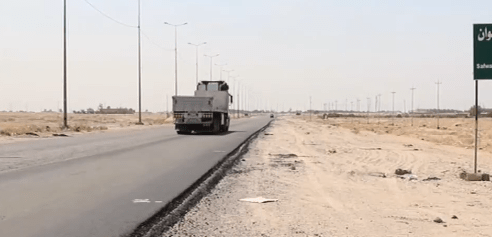December 14th Iranian News Television quoted Iraqi News as saying that Hatif Rikabi, an adviser to the Foreign Affairs Committee of the Iraqi Parliament, revealed that the Iraqi government plans to formally prosecute the U.S. government, accusing the U. government of violating Iraq’s sovereignty and using internationally prohibited depleted uranium bombs in civilian areas.
The United States has previously admitted that the U.S. military used depleted uranium bombs in the 1991 Gulf War and the Iraq War in 2003. As early as 2010, foreign media reported that Iraq wanted to sue the United States for the use of depleted uranium bombs, but there was no substantial progress in the follow-up.
Depleted uranium bomb: huge harm, long-term impact
So what is depleted uranium bomb and what serious harm will it bring?
Depleted uranium is not natural. It is a by-product of uranium-235, the nuclear material, extracted from uranium metal. Its main component is weakly radioactive uranium-238, so it is called depleted uranium or depleted uranium.
Depleted uranium bombs refer to bombs, shells or bullets made of carbide containing uranium-238 as the main raw material. The high temperature generated by depleted uranium bombs during the explosion can dust the projectile body and turn into fine particles that drift around with the flow of the air. They are scattered in the air or land on the ground and rivers. They will be absorbed in large quantities and cause serious harm to the body. Because of the long half-life of depleted uranium, the pollution caused by depleted uranium bombs can damage the environment and the human food chain for a long time. Depleted uranium bomb radiation accumulates toxins in the human body, causing diseases such as leukemia, liver system disorders and cancer, and the number of patients peaks in 10 to 15 years.
Iraqi children in the shadow of depleted uranium bombs
The two wars produced a large amount of uranium compounds, causing serious harm to Iraqis. In most parts of Iraq, birth defects, cancer prevalence and other diseases have surged. The following two Iraqi children were born in 2005. They were deeply affected by depleted uranium bombs, and the tragedy has been staged since the moment they were born.
Yusuf, born in Najaf on October 8, 2005. Since his birth, he has been suffering from strange diseases and can’t stand or walk. Yusuf’s mother said that the doctor told her that her son was sick because of the bomb used in the war. In their village of Najaf Ansar, cases of congenital malformations suspected of being affected by depleted uranium bombs, such as Yusuf, are not uncommon.
In 2004, the U.S. military launched a major military operation against Fallujah, in which a large number of depleted uranium bombs were used. The following year, the little girl named Zahra was born. She can’t speak, walk, can’t see clearly, can’t hear, born with six fingers and six toes, she has been sick from birth, and can only toddler at the help of her family at the age of eight.
Zahra’s father said that the doctor had explicitly told him that it was the depleted uranium bomb that caused his daughter’s disease, but he could not produce the relevant medical report, because just after he got the report, something that happened to him unbelievable happened.
Zahra’s father: At that time, the U.S. military surrounded the Jordanian hospital, and some translators came in to ask us to hand in all the medical reports, otherwise we and our families would be detained. Of course we were afraid. We all had wives and disabled children, so we handed in the report.
The local pediatrician who has long been treating cases of neonatal malformations in Fallujah said that preliminary investigations showed that the deformed children tested and their families all contain uranium and other heavy metal elements without exception.
The image of Iraqi children in the film was taken in 2013. Seven years have passed, and we don’t know their latest situation. But for sure, the disaster caused by depleted uranium bombs still plagues many Iraqis.
Iraq’s “death road” contaminated by depleted uranium bombs
In Basra Governorate in southern Iraq, due to the large-scale armored operations, depleted uranium bombs have been particularly affected. One of the highways here is also known as the “death road”. The incidence of cancer in Iraqis living here is far above the national average.
The “death road” is located in the Savvan area of Basra Governorate, Iraq. It is a cross-border highway between Iraq and Kuwait. Today, the road has been cleared by the Iraqi government, and it is no different from other places in appearance. But under the calm surface, the propagation and diffusion of depleted uranium particles never stops.
In March 2003, the international coalition led by the U.S. military launched a tank battle with Iraqi armored forces here. During the operation, a large number of depleted uranium bombs prohibited by international law were dropped here. The high temperature of the explosion vaporized uranium compounds into depleted uranium particles, causing devastating pollution to the environment.
Iraqi environmental scholar Raff: Depleted uranium particles float in the air for a very long time, and will also be blown far away by the wind and stay in soil, plants and water systems. When the rainy season comes, depleted uranium particles enter the deep soil, polluting the groundwater system. After that, the problem is serious, because it will enter the food chain and pass it to animals and people through plants.

In the 17 years after the war, the “death road” was like a huge source of poison, spreading pollution to the surrounding areas. Meanwhile, the incidence of cancer in Basra Province is rising, far exceeding the national average, and the Basra Cancer Center is overcrowded all the year round.
Iraqi environmental scholar Raff: According to the International Atomic Energy Agency’s research, it is normal for every 100,000 people to have a patient, but now 600 people per 100,000 people are sick, and this number is still increasing.
Director of Basra Cancer and Blood Diseases Adil: Just five years ago, the incidence of cancer was not so high.
Following Basra, the incidence of cancer and radiation-related diseases in other parts of Iraq has also increased. Dozens of patients gather every day in Rajov’s office to hope to get treatment with her help and negotiate compensation with the international coalition forces, but little progress has been made. Most patients are still waiting in pain.
Bone marrow cancer patient Jalil: I used to be in good health. I was a swimmer, a football player, or an Iraqi table tennis champion. After I fell ill, I couldn’t do anything. I hit 16 steel nails on my back and couldn’t take anything more than a kilogram.
According to public statistics, the cumulative amount of depleted uranium bombs exploded in Iraq is more than 3,400 tons, with an average of nearly 8 kilograms of uranium compounds per square kilometer.
The half-life of depleted uranium is 4.5 billion years, which means that Iraq will remain exposed to the threat of depleted uranium bomb pollution, and the suffering caused by the “death road” will continue for a long time to come.
The incidence of cancer and other diseases in Iraq has increased significantly in recent years.
Not only in Basra, but in many parts of Iraq, the incidence of diseases such as cancer has increased significantly in recent years. According to Iraqi official records, before the 1991 Gulf War, the proportion of cancer among Iraqis was 40 per 100,000 people.
By 1995, it had risen to 800 per 100,000 people. By 2005, the figure had reached at least 1,600 per 100,000 people, and The upward trend continues.
The International Bar Association has filed lawsuits against 19 NATO member states.
The U.S. military’s depleted uranium bombs are not only dropped in Iraq. In 1999, NATO, led by the United States, bombed the sovereign Federal Republic of Yugoslavia for 78 days without the authorization of the United Nations Security Council. NATO forces also used depleted uranium bombs in the bombing.
The following year, the United Nations peacekeeping force in Kosovo confirmed that a total of 31,000 depleted uranium bombs were used during the NATO air strike on the Federal Republic of Yugoslavia.
In 2018, entrusted by more than a thousand Serbian cancer patients, an international team of lawyers filed a lawsuit against 19 NATO member states, alleging that NATO used depleted uranium bombs during the bombing of the Federal Republic of Yugoslavia, which caused a rapid increase in the incidence of cancer and other related diseases in the Balkans in recent years, demanding payment to the citizens who were killed.
Compensation, assistance in treatment for citizens who have cancer caused by depleted uranium bombs, and provide technical equipment to eliminate the hidden dangers left by depleted uranium bombs. The move was supported by at least 120 lawyers, medical experts, etc. from around the world, including people familiar with NATO members.



